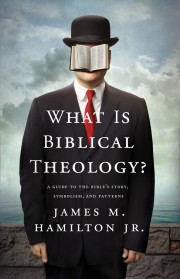Reviewed by Fred G. Zaspel
The blossoming of the discipline of a Geerhardus Vos flavored Biblical Theology in our generation has been to the benefit and blessing of Christians everywhere. The renewed awareness of the Bible story and of its relentless focus on the Lord Jesus Christ has opened the Bible, as for the first time, for many. We still acknowledge, of course, that Systematic Theology must come next in the theological enterprise, but the more careful tracing out of the Bible story with all its recurring promises, themes, patterns, and symbols has served only to enrich our understanding of the broader biblical context from which those systematic conclusions are derived and deepen our commitment to them.
Our generation has seen both comprehensive tomes and highly specialized investigations of various themes and “inter-canonical connections,” and in this context it becomes increasingly needful to have a simple, clear, entry-level introduction to what this is all about. This is the first value of Jim Hamilton’s What Is Biblical Theology? In scarcely 100 pages of text he traces out the Bible’s plot line in broad strokes, underlining the major players, movements, themes, and patterns that make Scripture a single book.
Following two chapters in which Hamilton provides a description of Biblical Theology and places it in context, he highlights “The Bible’s Big Story” (Part 1; chapters 3-5). From the Eden Cosmic Temple to Israel’s Tabernacle and Temple to the New Heavens and New Earth, from the primal kingdom ruined to God’s kingdom forever established, and from the assault of Satan — and his rebellious attempt to dethrone God and take from him what is his — to his final destruction, the story plays out in a theater and on a stage created by God to display his own glory in world history. The major episodes in the plot Hamilton draws out are Exile from Eden, Exodus from Egypt, Exile from the Land, The Cross, and The Promised Return, all informed by successive promises and symbolic anticipations and advancing the theme of God’s glory displayed in salvation through judgment (reminiscent of Hamilton’s larger previous work, God’s Glory in Salvation Through Judgment, also from Crossway).
In Part 2 (chapters 6-9) Hamilton surveys the imagery employed by the biblical writers to inform the expectation of fulfilled promise — “shadows” cast from the reality that is in Jesus. Tree, Flood, Temple, people, events, and institutions, feasts, the righteous sufferer, and patterns of events all are used in a prospective way that deepens the richness of our understanding of God’s purpose and the hope it affords. Again, Hamilton treats these matters in brief but suggestive fashion, cuing in the Bible reader to the signposts built into the biblical text that point us forward to New Testament truths brought about in the person and work of Christ.
Not to leave all this in the abstract, in Part 3 (chapters 10-13) Hamilton describes the church’s identity, place, and role in this unfolding divine purpose, continuing to trace out its various Old Testament connections. Though marked by struggle throughout this age God’s kingdom will come. God’s will indeed will be done on earth as in heaven. And God will dwell in his temple with his people at last.
In brief, Hamilton’s What is Biblical Theology? seeks to provide in big picture the Bible story, highlight its major movements and the various methods by which that story is told, and present the Christian church within this broader biblical perspective. Biblical theologians may quibble, wishing Hamilton had included this or that detail. Of course. But the work is not meant to be exhaustive but entry-level. Still, it is Bible saturated and well informed, and it provides a helpful aerial view of the forest for those who wish to begin making their way among the trees. And it does so in a winsome and engaging way.
Biblical Theology is consistently exciting and enriching, and this little book illustrates the point well. And it is enormously important for Christians — for understanding their Bibles, for understanding the gospel, and for understanding their role in the divine purpose of the ages — to become acquainted with the Bible story and to see how Scripture holds together from beginning to end. For classrooms in the church Sunday School, Bible college, Christian university, seminary, and individual Christians, Hamilton’s What Is Biblical Theology serves well as a guide for profitable Bible reading and as a helpful preview to the larger discipline of Biblical Theology. A most enjoyable, brief, accessible, spiritually uplifting introduction to a grand subject.
Fred G. Zaspel is Pastor of Reformed Baptist Church in Franconia, PA, professor of theology at Calvary Baptist Seminary, and executive editor here at Books At a Glance.
